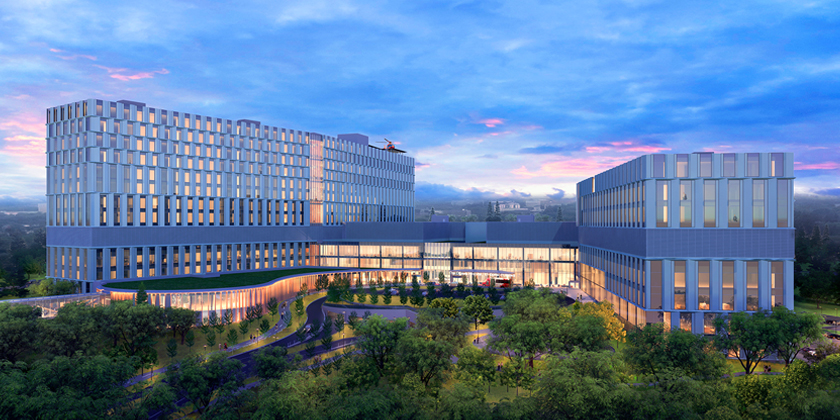Growing health: how a green roof improves wellness, sustainability and planetary health
Oct 23, 2024

During the early stages of a major infrastructure project like the construction of a new hospital, it’s easy to focus on the obvious visible elements at ground level: dirt, steel, concrete and the like.
And rightfully so; this is the current scene as crews build the parking garage that will support The Ottawa Hospital’s (TOH) new campus.
Design plans for our new hospital and campus are fundamentally guided by the health of people and the health of our planet. The Ottawa Hospital is committed to building a hospital and surrounding campus that have positive impacts on the environment, the community and the people who use it and we’re looking at all opportunities from floor to ceiling roof.
Current design plans for the new campus include the installation of a green roof in two areas on top of the main hospital building and on a portion of the parking garage.
Why go green?
At a rudimentary level, a green roof is a roof where vegetation grows. Green roofs can provide beneficial views of natural landscapes, helping to promote a sense of calm and escape during potentially stressful situations.
“There is good evidence to support that when hospitals incorporate natural design elements or provide views of the natural environment, generally, patient wellness is improved – it can even help reduce their length of stay or the amount of medical interventions that are required,” says Peter Duckworth-Pilkington, Sustainable Design Lead at HDR Architecture Associates Inc., a global health care design firm that is working with TOH to develop the new campus. “Having a view of the outdoors in a space typically devoid of nature has been shown to have a profound effect on one’s well-being.”
TOH is creating spaces throughout the new campus that promote health and healing by creating a connection to the natural environment.
“We’ve heard from partners informing our planning that being connected to natural landscapes is essential for overall wellness,” says Karen Stockton, Executive Director of Planning and Development at TOH. “We are working with communities to integrate natural elements and landscaping that reflect the region as well as homelands of patients from as far away as Nunavut.”

Green roofs also help reduce energy consumption and improve overall air quality.
“As an extension of the natural landscape above the urban fray, a green roof captures pollutants and releases oxygen, so it helps improve our overall air quality,” says Peter. “It absorbs carbon from the atmosphere while also providing space for butterflies and other pollinators, which is fantastic.”
Other benefits include extending the lifespan of the roof itself.
Compared to traditional commercial roofs often surfaced by material like metal sheeting or asphalt, a green roof will help keep indoor temperatures cooler in the summer and warmer in the winter, reducing air conditioning and heating requirements, respectively. It will also play an important role in stormwater management.
“Green roofs have additional benefits when it comes to planning building systems and site services at the new campus, including managing stormwater accumulation during large rainfall events. It will help absorb and evaporate water, mitigating the overloading of existing municipal stormwater infrastructure and reducing potential flooding on the grounds,” says Mike McKay, Senior Project Manager, Building Systems and Commissioning at The Ottawa Hospital. “Among other benefits that minimize impact to the environment, a green roof essentially acts like a sponge, slowing down that rate of storm water flow into the city system.”
Plant species for the green roofs at the new campus would be those typically found in alpine conditions and native to the Greater Ottawa Area and surrounding regions. In addition to designing one of Toronto’s first green roofs on his own home in 2003, Peter has worked on green roof projects for both Hennick Bridgepoint Hospital and Humber River Hospital in Toronto. He explains the plant selection specific to climate is essential for success.
“The Ottawa region has a very thin soil that lies over the Canadian shield – over granite,” he says. “Think about the green roof like that; we have a concrete structure (the building) which is the granite and then we have a thin layer of soil. It’s a wide spectrum of plants, but as an example, species like sedums (with water-storing leaves) are shown to thrive in this particular environment and are highly adapted to endure drought and rain cycles.”
In addition to the green roof, TOH has plans for a publicly accessible rooftop park on top of the parking structure. This dedicated area would have deeper soil than the green roof on other areas of the parking garage or main hospital building.
“This is where we’re basically taking the ground plane and lifting It up,” says Peter. “We can plant full-size trees there and you won’t even know you’re not on the ground – a feeling of literally being in a park in the sky.”


